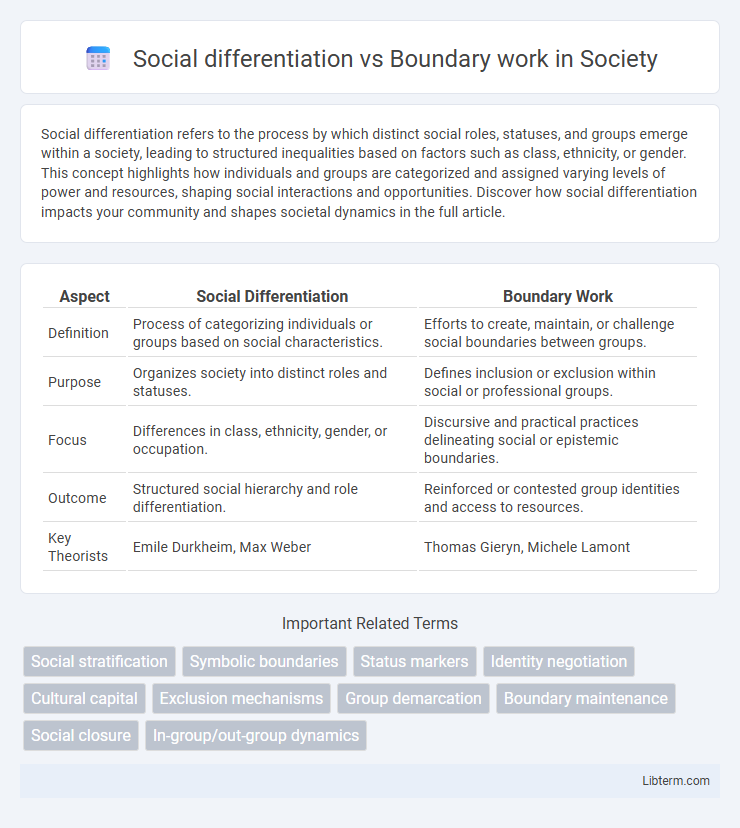Social differentiation refers to the process by which distinct social roles, statuses, and groups emerge within a society, leading to structured inequalities based on factors such as class, ethnicity, or gender. This concept highlights how individuals and groups are categorized and assigned varying levels of power and resources, shaping social interactions and opportunities. Discover how social differentiation impacts your community and shapes societal dynamics in the full article.
Table of Comparison
| Aspect | Social Differentiation | Boundary Work |
|---|---|---|
| Definition | Process of categorizing individuals or groups based on social characteristics. | Efforts to create, maintain, or challenge social boundaries between groups. |
| Purpose | Organizes society into distinct roles and statuses. | Defines inclusion or exclusion within social or professional groups. |
| Focus | Differences in class, ethnicity, gender, or occupation. | Discursive and practical practices delineating social or epistemic boundaries. |
| Outcome | Structured social hierarchy and role differentiation. | Reinforced or contested group identities and access to resources. |
| Key Theorists | Emile Durkheim, Max Weber | Thomas Gieryn, Michele Lamont |
Understanding Social Differentiation: Key Concepts
Social differentiation involves the division of society into distinct social groups based on characteristics like class, race, or gender, shaping individuals' roles and identities within social structures. Boundary work refers to the processes through which social groups define, maintain, or challenge these divisions by creating symbolic or physical distinctions. Understanding social differentiation requires examining how power dynamics and social interactions influence the creation and reinforcement of social boundaries and contribute to social inequality.
Defining Boundary Work in Social Contexts
Boundary work in social contexts refers to the processes by which individuals and groups distinguish and maintain the distinctions between social categories or domains, often to assert identity, legitimacy, and control over resources. This concept highlights how social actors actively construct and negotiate boundaries to differentiate themselves from others, influencing social differentiation by reinforcing inclusion and exclusion criteria. Defining boundary work involves examining the symbolic, cultural, and institutional practices that create, sustain, or challenge social divisions in various settings.
Historical Perspectives on Social Differentiation
Historical perspectives on social differentiation reveal how groups have established distinct identities based on class, race, gender, or ethnicity, influencing social hierarchy and power distribution. Boundary work involves the active process of maintaining and negotiating these social distinctions to protect group interests and cultural meanings. Studies from sociologists like Georg Simmel and Erving Goffman emphasize how social differentiation shapes interaction patterns and institutional frameworks over time.
Theoretical Foundations of Boundary Work
Boundary work is grounded in social constructivist theories emphasizing how social groups actively create and maintain distinctions to establish identity and authority. It involves negotiating and reinforcing social boundaries that separate insiders from outsiders, which is central to understanding social differentiation as a dynamic process rather than a fixed state. Theoretical foundations draw from symbolic interactionism and systems theory, highlighting the role of discourse, power relations, and institutional practices in boundary construction and maintenance.
Social Differentiation vs Boundary Work: Core Differences
Social differentiation refers to the process by which distinct social categories or groups emerge based on characteristics such as class, ethnicity, or occupation, creating structured inequalities within society. Boundary work involves the active efforts by individuals or groups to establish, maintain, or challenge social distinctions and identities, often negotiating power dynamics and group membership. The core difference lies in social differentiation describing the existence of social divisions, whereas boundary work focuses on the dynamic processes that reinforce or contest these divisions.
Mechanisms that Drive Social Differentiation
Mechanisms that drive social differentiation include economic disparities, cultural distinctions, and institutional roles that create hierarchical layers within society. Social differentiation occurs as groups develop unique identities based on class, ethnicity, or occupation, reinforcing social stratification. Boundary work sharpens these divisions by defining in-group and out-group memberships through symbolic practices and social norms.
How Boundary Work Shapes Group Identities
Boundary work plays a crucial role in shaping group identities by defining and maintaining distinctions between social groups through symbolic markers, language, and practices. It involves the active construction and negotiation of social boundaries that reinforce group cohesion and delineate insiders from outsiders. This process influences social differentiation by legitimizing group-specific norms and values, thereby strengthening collective identity and social stratification.
Overlaps and Intersections between Differentiation and Boundary Work
Social differentiation involves categorizing individuals or groups based on characteristics such as class, ethnicity, or occupation, creating distinct social strata. Boundary work refers to the efforts by individuals or groups to construct, maintain, or challenge social boundaries that separate these categories. Overlaps and intersections occur when social differentiation shapes the boundaries people negotiate, with boundary work highlighting the dynamic processes that reinforce or blur social divisions embedded in differentiation.
Case Studies: Real-World Examples of Both Concepts
Social differentiation is exemplified in caste systems of India where rigid hierarchical categories organize individuals by birth, impacting access to resources and social status. Boundary work is evident in professional fields like medicine, where occupational groups define and defend their expertise to maintain authority and control over knowledge. Case studies illustrate how social differentiation creates structural divisions, while boundary work actively negotiates and reinforces social distinctions within and across groups.
Implications for Contemporary Social Relations
Social differentiation refers to the division of society into distinct groups based on characteristics such as class, ethnicity, or occupation, shaping access to resources and power dynamics. Boundary work involves defining and negotiating social boundaries to maintain group identities and exclude others, reinforcing social hierarchies and segregation. Understanding these processes elucidates how contemporary social relations are structured by both systemic inequalities and active efforts to protect group interests and identities.
Social differentiation Infographic

 libterm.com
libterm.com